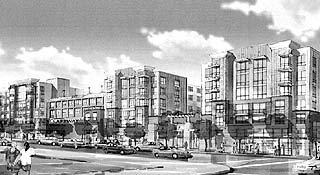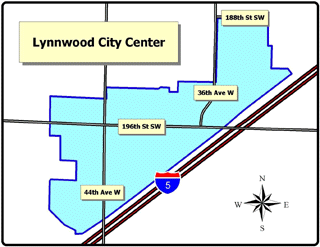
Surveys
DJC.COM
February 28, 2002
A tale of two cities’ downtowns
Special to the Journal

Federal Way is studying developments in other cities, including Bellevue’s Avalon on the Square project shown above.
|
Where Pacific Highway meets 320th Street in south King County, drivers pass a Good Guys electronics store, an Arco gas station, a Washington Mutual and a Bank of America.
Those who traverse the south Snohomish County intersection of 196th and 44th can stop by Precision Auto Tune, U.S. Bank, a medical clinic or Jack-in-the-Box.
Welcome to downtown Lynnwood and Federal Way — or rather, in the proper order, Federal Way and Lynnwood. Both have banks, bustling retail and detailed plans for the future. Both have a foundation for infrastructure, revenue and real estate — the tools to put their plans to work. Federal Way even has ornamental streetlamps, wide sidewalks, stone columns and greeting signs. But other than that, at this early stage, even city officials admit it’d be easy to mix them up.
“People like the idea of a downtown Lynnwood. You ask people where they think downtown is now, they have a different answer,” said Jim Cutts, Lynnwood’s community development director.
Invariably, in both cities, that answer is often the same.
Where’s downtown? To many, it’s the mall.
“In the suburban pattern, there’s nothing unique about Federal Way,” said Patrick Doherty, the city’s deputy director of economic development. “This five-year period is really important. There will be a place people will consider a downtown. If we start to make some progress, we could do a lot.”
But ultimately, accomplishing an ambitious vision for downtown Lynnwood or Federal Way, something along the lines of a smaller-scale Bellevue, will take closer to 20 years than five.
Lynnwood
With a $50 million renovation scheduled over the next four years, Lynnwood considers Alderwood Mall an anchor for future development — and possibly for downtown.
But officials hope a combination of upcoming projects will transform the suburb.
The push for a downtown Lynnwood began two years ago, when public and private officials saw the need for an office-space alternative to Seattle and the Eastside, said Jim Granger, president and CEO of Olympic Capital Group.

Lynnwood’s downtown boundaries.
|
“The thinking was, if there’s a perception of a need for less expensive office space, what can we do about it?” Granger said. “The first significant challenge is the market,” Granger said. “We’ll respond to the market when it returns.”
Lynnwood has plans for a $50 million Sound Transit upgrade, a 35,000-square-foot conference and convention center and a park-and-ride center at the central business district’s south end.
The city’s master plan envisions a Lynnwood downtown marked by parking garages, low-rise buildings and foot traffic, with the tallest buildings centered along both sides of 198th, or Main Street. A city-sponsored video describes a 400-acre planning area that could host up to 6 million square feet of office space, 1.5 million of retail and 4,000 apartments and condominiums near the confluence of Interstates 5 and 405.
“We want to create a situation where people can live in the area and walk to work,” Cutts said.
The plan will outline design standards and zoning codes. Set for completion in November, it will follow a 15-month, $500,000 study commissioned last year by the city, county, public facilities district, Lynnwood Chamber of Commerce and Sound Transit. The cost also funds an environmental impact study.
“A lot of people have a lot of stake in what’s going on,” Granger said.
Under the plan, Lynnwood Economic Development Director David Kleitsch expects downtown buildings will have “sustainable” designs of high enough quality to attract investors. The plan will set height limits, encourage mixed-use projects and intersperse concrete with trees and parks. Single-use housing will sit along the edge of the central core.
“Public spaces need to connect to private spaces. The future of Lynnwood is based on the past,” Kleitsch said. “We’ve got retail and shopping like you wouldn’t believe. We need to round it out.”
Federal Way
Federal Way is trying to build a similar downtown, Doherty says it may take more time. He can rattle off the city’s pluses: It sits along a major highway near a major airport between the Port of Tacoma and the Port of Seattle. It’s filled with retail. With annexation, its population could beat 130,000 by 2020.
But becoming another Bellevue may prove elusive for Federal Way, Doherty concedes.
A surge in demand for office space helped Bellevue develop the biggest downtown on the Eastside. Federal Way already has a few million square feet of office space. It’s outside Federal Way’s future “city center,” but it’s available, and it’s cheaper.
“If we didn’t already have a huge amount of office space, we’d have to put it downtown,” Doherty said. “We aren’t putting our eggs in that basket that much.”
Federal Way is taking a different route. There are plans to build a new City Hall downtown. There are plans for a Sound Transit center in 2004. The land use code Federal Way wrote after residents voted to incorporate in 1990 forces private developers in the city center to build close to the street. The city is researching code changes to leverage housing and office space from big-box retailers.
“Most of the remaining area here capable of absorbing multi-family housing is in the city center,” Doherty said.
The goal, public and private officials agree, is to replace mammoth parking lots with foot traffic. Also to that end, Delores Shull, president and CEO of the Federal Way Chamber of Commerce, described proposals to change the city’s land use code.
If the chamber has its way, businesses upgrading the value of a structure by 25 percent or more must also pay for frontage improvements. And developers considering a home in Federal Way would be able to build and start business more quickly.
“Basically, businesses want to get up and running as soon as possible,” Shull said. “We want to be a welcome city for business. We’re making it easy for them to be successful here.”
Doherty expects downtown Federal Way to center around public buildings, public transit, dense retail and residential real estate — not just SeaTac Mall. With views of Mt. Rainier and the Olympics, plus the city’s shortage of luxury apartments and condominiums, Doherty believes developers and house-hunters will have to consider downtown Federal Way an alternative.
“Now, it’s retail, retail, retail. We need to start getting a better mix,” Doherty said.
With Snohomish County expected to gain 100,000 new residents by 2020, Granger believes Lynnwood has a chance to build a true downtown as well.
“North and south of Seattle, the population is going to increase. That means places like Federal Way and Lynnwood. No question about it,” he said. “That will drive the creation of suburban cities.”
Ari Kramer is a Seattle-based freelance writer.
Other Stories:
- What’s in store for investors in 2002
- Leasehold title insurance: New ALTA endorsements
- 4,000 hours of training to change a light switch?
- Market grows for affordable assisted living
- Beer distributor serves up Arlington
- 2,158 reasons to like nonprofit housing groups
- Regulation reform can help jump-start the region
- Condo legislation creates legal slugfest
- Managing churn without feeling the burn
- Workplace design can improve productivity
- Spokane: A study in steady growth
- Recession? Don’t worry, it’s just a cycle
- Work-site schools teach a lesson to developers
Copyright ©2009 Seattle Daily Journal and DJC.COM.
Comments? Questions? Contact us.